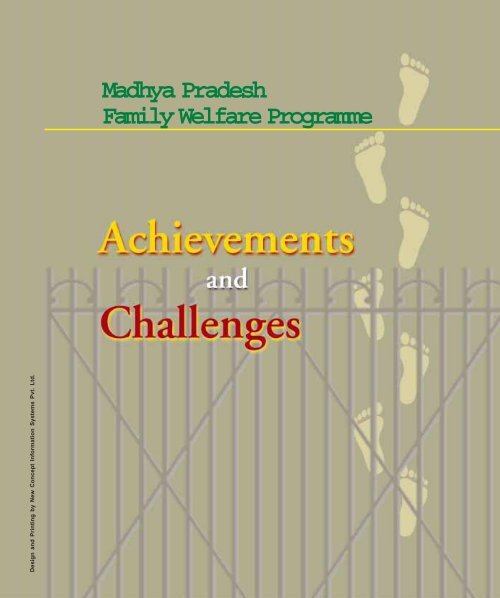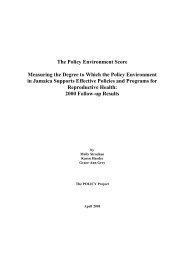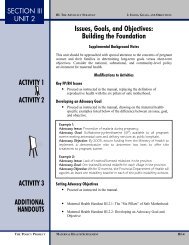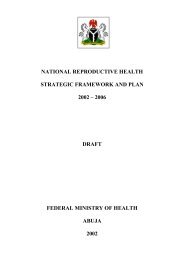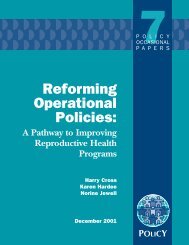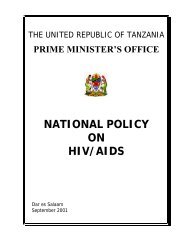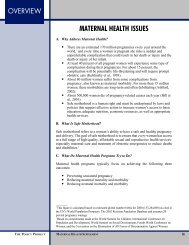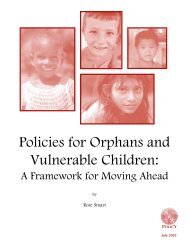Madhya Pradesh Family Welfare Programme - POLICY Project
Madhya Pradesh Family Welfare Programme - POLICY Project
Madhya Pradesh Family Welfare Programme - POLICY Project
Create successful ePaper yourself
Turn your PDF publications into a flip-book with our unique Google optimized e-Paper software.
Design and Printing by New Concept Information Systems Pvt. Ltd.<br />
<strong>Madhya</strong> <strong>Pradesh</strong><br />
<strong>Family</strong> <strong>Welfare</strong> <strong>Programme</strong>
<strong>Madhya</strong> <strong>Pradesh</strong><br />
<strong>Family</strong> <strong>Welfare</strong> <strong>Programme</strong><br />
Achievements<br />
and<br />
Challenges<br />
July 1999
The <strong>POLICY</strong> <strong>Project</strong><br />
The Futures Group International<br />
in collaboration with:<br />
Research Triangle Institute (RTI)<br />
The Centre for Development and Population Activities (CEDPA)<br />
<strong>POLICY</strong> is a five-year project funded by the U.S. Agency for International Development<br />
under Contract No. CCP-C-00-95-00023-04, beginning September 1, 1995. It is<br />
implemented by The Futures Group International in collaboration with Research<br />
Triangle Institute (RTI) and the Centre for Development and Population Activities<br />
(CEDPA). The views expressed in this report do not necessarily reflect those of USAID.
ds- ,l- ’kekZ<br />
eq[; lfpo<br />
Chief Secretary<br />
e/;çns’k ’kklu<br />
cYyHk Hkou] Hkksiky & 462002<br />
Government of <strong>Madhya</strong> <strong>Pradesh</strong><br />
Vallabh Bhavan, Bhopal - 462004<br />
Bhopal, Dated 17.7.1999<br />
The population of <strong>Madhya</strong> <strong>Pradesh</strong> has been increasing rapidly over<br />
the past few decades. The population that was 30 million in 1957 has<br />
now reached around 70 million. Change in fertility behaviour and<br />
contraceptive use has paid some dividends but a holistic approach to<br />
realize the objective of reaching replacement level of fertility is<br />
required.<br />
It is essential to take into consideration the paradigm shift envisaged<br />
by the Government of India following the ICPD declaration in 1994.<br />
Morbidity, mortality and health status of women and children have a<br />
direct bearing on the fertility behaviour. Rapid fertility decline is<br />
possible when all these factors are taken into consideration along<br />
with those such as age at marriage, female literacy and so on that have<br />
unintended but significant consequences. It is, therefore, imperative<br />
that all development departments should make an effort to this<br />
holistic approach and then only the objective of reaching replacement<br />
level of fertility can be a reality.<br />
This volume prepared by The Futures Group International and<br />
Indian Institute of Health Management Research (IIHMR) in<br />
collaboration with the Department of Health and <strong>Family</strong> <strong>Welfare</strong>,<br />
Government of <strong>Madhya</strong> <strong>Pradesh</strong>, is a step in the right direction to<br />
educate policy makers, programme managers and others.<br />
(K.S. Sharma)
Contents<br />
Achievements 7<br />
Population and<br />
Development<br />
17<br />
Current Demographic<br />
Objectives<br />
25<br />
Challenges<br />
33<br />
Summary<br />
41
Achievements
<strong>Madhya</strong> <strong>Pradesh</strong> <strong>Family</strong> <strong>Welfare</strong> <strong>Programme</strong><br />
Historical Population Growth<br />
100<br />
90<br />
96 crores<br />
80<br />
70<br />
60<br />
50<br />
51<br />
40<br />
30<br />
20<br />
10<br />
4<br />
7.6 crores<br />
0<br />
(8% of total)<br />
1971 1981 1991 1997<br />
<strong>Madhya</strong> <strong>Pradesh</strong> India<br />
The estimated population of <strong>Madhya</strong> <strong>Pradesh</strong> in 1997 was<br />
7.6 crores, which constitutes 7.9 percent of the total population<br />
of India. This proportion has remained more or less the same<br />
since 1971.<br />
8
<strong>Madhya</strong> <strong>Pradesh</strong> <strong>Family</strong> <strong>Welfare</strong> <strong>Programme</strong><br />
Rate of Population Growth<br />
Population per 1000<br />
45<br />
40<br />
35<br />
<strong>Madhya</strong> <strong>Pradesh</strong><br />
India<br />
2.2<br />
30<br />
25<br />
20<br />
15<br />
10<br />
5<br />
2.0<br />
0<br />
1971 1981 1986 1991 1997<br />
Birth Rate<br />
Death Rate<br />
Source: Government of <strong>Madhya</strong> <strong>Pradesh</strong>, 1997.<br />
The population growth rate has decreased steadily since the advent<br />
of the family planning programme. The national growth rate is now<br />
2 percent, while the growth rate in <strong>Madhya</strong> <strong>Pradesh</strong> is 2.2 percent.<br />
However, throughout the 20th century, population growth has<br />
outpaced resources. Given the scarce and limited resources in<br />
<strong>Madhya</strong> <strong>Pradesh</strong>, the state cannot afford continued population<br />
growth.<br />
9
<strong>Madhya</strong> <strong>Pradesh</strong> <strong>Family</strong> <strong>Welfare</strong> <strong>Programme</strong><br />
Trends in Population Growth<br />
Population Size Year Period of Achievements<br />
s<br />
s<br />
s<br />
s<br />
s<br />
s<br />
First Crore 1821 —<br />
Second Crore 1925 104 Years<br />
Third Crore 1957 32 Years<br />
Fourth Crore 1968 11 Years<br />
Fifth Crore 1978 10 Years<br />
Sixth Crore 1987 9 Years<br />
Seventh Crore 1994 7 Years<br />
Presently, the population of <strong>Madhya</strong> <strong>Pradesh</strong> is over 7 crores. It<br />
reached its first crore in the year 1821 and to reach its second crore<br />
mark, it took 104 years. Due to drastic decline in mortality that has<br />
outpaced the decline in fertility, the population has increased rapidly<br />
and at current pace of growth rate it is taking only seven years to<br />
add a crore to its population base.<br />
10
<strong>Madhya</strong> <strong>Pradesh</strong> <strong>Family</strong> <strong>Welfare</strong> <strong>Programme</strong><br />
Total Fertility Rate<br />
6.5<br />
6<br />
5.5<br />
5<br />
5.4 5.6 4.5<br />
5.2<br />
India<br />
<strong>Madhya</strong> <strong>Pradesh</strong><br />
4.5<br />
4<br />
3.5<br />
3.6<br />
3.9<br />
3.4 3.5<br />
3<br />
2.5<br />
2<br />
1.5<br />
1<br />
0.5<br />
0<br />
1971 1981 1991 1997<br />
The average number of children that a woman in India would have in<br />
her lifetime (the total fertility rate [TFR]) was 5.4 in 1971, while it<br />
was 5.6 in <strong>Madhya</strong> <strong>Pradesh</strong>. By 1997, the TFR for India, as well as<br />
<strong>Madhya</strong> <strong>Pradesh</strong> had declined to 3.4 and 3.5 respectively. As a<br />
matter of fact, the decline in fertility since 1991 has been more rapid<br />
in <strong>Madhya</strong> <strong>Pradesh</strong> than the nation as a whole.<br />
11
<strong>Madhya</strong> <strong>Pradesh</strong> <strong>Family</strong> <strong>Welfare</strong> <strong>Programme</strong><br />
Fertility Reduction Slowed Population Growth by<br />
4.3 Million (1971-1997)<br />
6<br />
5.5<br />
5<br />
4.5<br />
4<br />
3.5<br />
3<br />
2.5<br />
2<br />
1.5<br />
1<br />
0.5<br />
0<br />
5.6<br />
80.7 million<br />
4.3 million<br />
addition<br />
TFR 5.6 TFR 3.5<br />
3.5<br />
76.4 million<br />
6<br />
5.5<br />
5<br />
4.5<br />
4<br />
3.5<br />
3<br />
2.5<br />
2<br />
1.5<br />
1<br />
0.5<br />
0<br />
If fertility in <strong>Madhya</strong> <strong>Pradesh</strong> has remained at the same level as in<br />
1971, the population size would have been 80.7 million. <strong>Family</strong><br />
planning efforts have averted the addition of 4.3 million persons in<br />
the last two and a half decades.<br />
12
<strong>Madhya</strong> <strong>Pradesh</strong> <strong>Family</strong> <strong>Welfare</strong> <strong>Programme</strong><br />
The Impact of <strong>Family</strong> Planning on Reducing TFR<br />
5.6<br />
50<br />
40<br />
7<br />
6<br />
5<br />
42%<br />
CPR<br />
30<br />
20<br />
4<br />
3<br />
TFR<br />
10%<br />
10<br />
2<br />
1<br />
3.5<br />
0<br />
0<br />
1971 5.6<br />
5.6 5.6<br />
Contraceptive Prevalence Rate (CPR)<br />
Total Fertility Rate (TFR)<br />
Increased use of modern contraceptive methods particularly in the<br />
last three decades has contributed to reduced fertility rate. Only 10<br />
out of 100 currently married women in the reproductive age group<br />
used family planning methods either to delay child birth or prevent<br />
having another child in 1971. The total fertility rate at that time was<br />
5.6. The use of modern contraceptives has increased sharply<br />
between 1971 and 1997. Forty two percent of currently married<br />
women in reproductive age group now use contraceptive methods<br />
either to space or to limit births. This four-fold increase in<br />
contraceptive method use has contributed to decline in fertility rate<br />
from 5.6 in 1971 to 3.5 in 1997. A reduction of two children per<br />
women in a period of three deades is a major achievement of the<br />
family welfare programme in <strong>Madhya</strong> <strong>Pradesh</strong>.<br />
13
<strong>Madhya</strong> <strong>Pradesh</strong> <strong>Family</strong> <strong>Welfare</strong> <strong>Programme</strong><br />
<strong>Family</strong> Planning Improves Child Survival:<br />
Birth Spacing Lowers Mortality<br />
Per 1000 live births<br />
200<br />
150<br />
155.7<br />
IMR<br />
100<br />
70.1<br />
50<br />
28.9<br />
0<br />
<strong>Madhya</strong> <strong>Pradesh</strong> <strong>Family</strong> <strong>Welfare</strong> <strong>Programme</strong><br />
Improved Development Indicators<br />
1971 1981 1991<br />
Infant Mortality 135 142 104<br />
Female Literacy 10.9 15.5 28.8<br />
Female Life Expectancy NA 51.5 54.7<br />
NA = not available<br />
Poverty and female literacy immensely influence the success of<br />
family planning programme efforts to increase the acceptance of<br />
contraceptive method use. Female literacy has increase from 11<br />
percent in 1971 to 29 percent in 1991. Increased coverage of<br />
children through universal immunization programme, higher<br />
proportion of deliveries assisted by trained professionals, and<br />
improved access to health services have created a favourable<br />
environment for reproductive health, resulting in reduced infant<br />
mortality rate. In <strong>Madhya</strong> <strong>Pradesh</strong>, the infant mortality rate was<br />
135 per 1,000 live births in 1971 and declined to 104 in 1991. In<br />
addition, female life expectancy increased from 51.5 to 54.7<br />
between 1981 and 1991. All these factors have contributed directly<br />
or indirectly to higher levels of contraceptive use, which in turn has<br />
contributed to improved maternal and child health in the state.<br />
15
Population and<br />
Development
<strong>Madhya</strong> <strong>Pradesh</strong> <strong>Family</strong> <strong>Welfare</strong> <strong>Programme</strong><br />
Benefits of <strong>Family</strong> Planning<br />
n Lowers child morbidity and mortality<br />
n Reduces maternal morbidity and mortality<br />
n Facilitates achievement of educational goals<br />
n Allows women to pursue employment opportunities<br />
n Promotes greater investment in each child<br />
<strong>Family</strong> Planning has many benefits. Most immediately, it improves<br />
the health of mother and child. In the long run, family planning also<br />
allows women to pursue further educational and employment<br />
opportunities. In addition, it promotes greater investments in the<br />
health, education, and future of each child, which is ultimately a<br />
greater investment in the future of <strong>Madhya</strong> <strong>Pradesh</strong>.<br />
18
<strong>Madhya</strong> <strong>Pradesh</strong> <strong>Family</strong> <strong>Welfare</strong> <strong>Programme</strong><br />
RCH Services and Education<br />
Modern Contraception<br />
Antenatal Care<br />
Vaccinations<br />
0 10 20 30 40 50 60 70 80 90 100<br />
Middle school<br />
Completed middle school<br />
High school<br />
Illiterate<br />
At the same time, the education level of mothers has direct influence<br />
on utilization of health facilities. The higher the level of education of<br />
mothers, the higher the utilization of health services. Efforts made<br />
by the government of <strong>Madhya</strong> <strong>Pradesh</strong> to improve the literacy<br />
levels of both men and women would contribute to better<br />
utilization of existing health facilities.<br />
19
<strong>Madhya</strong> <strong>Pradesh</strong> <strong>Family</strong> <strong>Welfare</strong> <strong>Programme</strong><br />
Population and Urbanization (2011) - in millions<br />
100<br />
90<br />
80<br />
70<br />
60<br />
50<br />
40<br />
30<br />
20<br />
10<br />
0<br />
1999<br />
2001 2003 2005 2007 2009 2011<br />
Urban population<br />
Total population<br />
According to the 1991 census, about 23 percent or 15 million<br />
population were living in urban areas. Assuming the decadal urban<br />
growth rate the estimated population in 1999 will be around 20<br />
million and is expectd to reach 30 million by 2011. With increasing<br />
urban population, the migration from rural to urban areas is bound<br />
to increase and therefore most of the urban growth will be due to<br />
migration and not due to natural increase. Consequently, there will<br />
be tremendous pressure on the urban resources such as land, water,<br />
housing, electricity and of course in providing basic health services.<br />
20
<strong>Madhya</strong> <strong>Pradesh</strong> <strong>Family</strong> <strong>Welfare</strong> <strong>Programme</strong><br />
Population and Primary School<br />
Requirements (000’s)*<br />
120<br />
110<br />
100<br />
90<br />
80<br />
70<br />
60<br />
50<br />
40<br />
30<br />
20<br />
10<br />
0<br />
115<br />
97<br />
TFR 3.5 TFR 2.1<br />
2011<br />
* Assume enrollment rate of 54%<br />
Source: <strong>Madhya</strong> <strong>Pradesh</strong> Human Development Report, 1998<br />
<strong>Madhya</strong> <strong>Pradesh</strong> currently has 78,794 primary schools with more<br />
than 9.6 million pupils, at an enrollment rate of 54 percent. At<br />
current enrollment levels, this number of schools would be<br />
sufficient if TFR 2.1 is achieved by 2011. However, assuming that<br />
<strong>Madhya</strong> <strong>Pradesh</strong> would achieve 100 percent enrollment by the year<br />
2001, the total number of primary school needed would be 97,000;<br />
if TFR remains at 3.5, <strong>Madhya</strong> <strong>Pradesh</strong> would need at least 115,000<br />
schools. After population stabilization, however, the number of<br />
schools required may slowly and gradually decline. Scarce resources<br />
can then be used to broaden enrollment and improve the quality of<br />
education. <strong>Family</strong> planning and reduced fertility can alleviate the<br />
population burden on the education sector, allowing it to better<br />
serve the children of <strong>Madhya</strong> <strong>Pradesh</strong>.<br />
21
<strong>Madhya</strong> <strong>Pradesh</strong> <strong>Family</strong> <strong>Welfare</strong> <strong>Programme</strong><br />
Labour Force (2011) - in lakhs<br />
300<br />
250<br />
278<br />
275<br />
200<br />
150<br />
100<br />
50<br />
0<br />
TFR 3.5 TFR 2.1<br />
Source: <strong>Madhya</strong> <strong>Pradesh</strong> Human Development Report, 1998<br />
If TFR remains at 3.5 in 2011, the labour force would reach 278<br />
lakhs. If <strong>Madhya</strong> <strong>Pradesh</strong> achieves replacement level of fertility by<br />
2011, the working population would be 275 lakhs. Decline in<br />
fertility contributes to lesser number of people seeking jobs. As a<br />
result, the rate of unemployment would also decrease.<br />
22
<strong>Madhya</strong> <strong>Pradesh</strong> <strong>Family</strong> <strong>Welfare</strong> <strong>Programme</strong><br />
Population without Access to Safe Drinking<br />
Water (2011) - in lakhs<br />
500<br />
400<br />
457<br />
429<br />
300<br />
200<br />
100<br />
0<br />
TFR 3.5 TFR 2.1<br />
Source: <strong>Madhya</strong> <strong>Pradesh</strong> Human Development Report, 1998<br />
Currently in <strong>Madhya</strong> <strong>Pradesh</strong>, 21 percent of the urban population<br />
and 55 percent of rural population do not have access to safe drining<br />
water facility. At these rates, the total population, without access to<br />
safe drinking water, will be 457 lakhs by 2011. However, if the total<br />
fertility rate declines to 2.1 by 2011, the total population without<br />
access to safe drinking water would be 429 lakhs, reducing the scope<br />
of the water problem for the government.<br />
23
<strong>Madhya</strong> <strong>Pradesh</strong> <strong>Family</strong> <strong>Welfare</strong> <strong>Programme</strong><br />
Population and Environment<br />
n 30.53% of <strong>Madhya</strong> <strong>Pradesh</strong> is Forest Cover<br />
n Per capita Forest Area declined by 23% from 1981-1991<br />
In addition to the water problem, population also affects the<br />
environmental sector. <strong>Madhya</strong> <strong>Pradesh</strong> is almost one-third forest,<br />
but the increasing population has created increasing demand for<br />
timber, fuelwood, and fodder. In one decade, per capita forest area<br />
decreased by 23 percent. <strong>Madhya</strong> <strong>Pradesh</strong> currently estimates that<br />
there are deficits of 24 metric tonnes of fuelwood and 41 metric<br />
tonnes of fodder. Continued rapid population growth will<br />
exacerbate these deficits and lead to further deforestation.<br />
24
<strong>Madhya</strong> <strong>Pradesh</strong> <strong>Family</strong> <strong>Welfare</strong> <strong>Programme</strong><br />
Current<br />
Demographic<br />
Objectives<br />
25
<strong>Madhya</strong> <strong>Pradesh</strong> <strong>Family</strong> <strong>Welfare</strong> <strong>Programme</strong><br />
Population Goals for <strong>Madhya</strong> <strong>Pradesh</strong><br />
1997<br />
3.4<br />
2011<br />
TFR<br />
3.5<br />
2.1<br />
2.0%<br />
Growth<br />
Rate<br />
2.2%<br />
1.2%<br />
The national government has recognized the negative impact of<br />
population growth on development. Currently, the family welfare<br />
programme objective for India is to achieve replacement level<br />
fertility and slow the population growth rate to 1.2 percent by 2016<br />
but <strong>Madhya</strong> <strong>Pradesh</strong> has decided to reach the population goal by<br />
2011 through concerted efforts.<br />
26
<strong>Madhya</strong> <strong>Pradesh</strong> <strong>Family</strong> <strong>Welfare</strong> <strong>Programme</strong><br />
Reaching Replacement Fertility by 2011<br />
6<br />
5<br />
4<br />
3.5<br />
TFR<br />
3<br />
2<br />
2.1<br />
1<br />
0<br />
1971<br />
1997 2011<br />
<strong>Madhya</strong> <strong>Pradesh</strong> has to reduce fertility rate by over two-fifths to<br />
reach replacement level of fertility. In recent times, TFR in <strong>Madhya</strong><br />
<strong>Pradesh</strong> has declined substantially from 4.2 in 1993 to 3.5 in 1999.<br />
Given this trend, <strong>Madhya</strong> <strong>Pradesh</strong> will be able to achieve<br />
replacement fertility in 2011.<br />
27
<strong>Madhya</strong> <strong>Pradesh</strong> <strong>Family</strong> <strong>Welfare</strong> <strong>Programme</strong><br />
Implications of delay in reaching<br />
replacement fertility<br />
120<br />
100<br />
Difference<br />
in 2016:<br />
16 million<br />
80<br />
60<br />
40<br />
20<br />
0<br />
1997<br />
1999<br />
2001<br />
2003<br />
2005<br />
2007<br />
2009<br />
2011<br />
2013<br />
2015<br />
TFR 2.1 TFR 3.5<br />
Stabilizing population by 2011 would save <strong>Madhya</strong> <strong>Pradesh</strong> from an<br />
additional population increase of 16 million by the year 2016.<br />
However, because it is starting from a high fertility rate of 3.5,<br />
<strong>Madhya</strong> <strong>Pradesh</strong> has to invest more resources and place more<br />
emphasis on innovative programme implementation strategies than<br />
many other states in India. The family planning programme must be<br />
a state priority because it is not merely a programme to enhance the<br />
welfare of women and children but an economic necessity.<br />
Investments made into the family welfare programme help reap rich<br />
dividends later.<br />
28
<strong>Madhya</strong> <strong>Pradesh</strong> <strong>Family</strong> <strong>Welfare</strong> <strong>Programme</strong><br />
Contraceptive Prevalence Rate<br />
100<br />
80<br />
60<br />
61%<br />
CPR<br />
40<br />
42%<br />
20<br />
0<br />
Current<br />
GOAL<br />
In order to achieve replacement level fertility by 2011, the<br />
contraceptive prevalence rate must increase to 61%. On average,<br />
two out of every three women of reproductive age in <strong>Madhya</strong><br />
<strong>Pradesh</strong> will need to use a modern method of contraception.<br />
29
<strong>Madhya</strong> <strong>Pradesh</strong> <strong>Family</strong> <strong>Welfare</strong> <strong>Programme</strong><br />
Number of Users Required in 2011<br />
Users (in millions)<br />
2011<br />
13<br />
2009<br />
2007<br />
2005<br />
2003<br />
2001<br />
1999<br />
7<br />
0 2 4 6 8 10 12 14<br />
In order to increase contraceptive prevalence to the necessary level<br />
by 2011, <strong>Madhya</strong> <strong>Pradesh</strong> will have to recruit and provide services<br />
to 13 million users. This is nearly double the current number and<br />
requires a high level of effort and resources. In other words,the<br />
contraceptive prevalence will have to increase each year by 1.5<br />
points that looks feasible. An increase at this pace will also allow the<br />
health system to ensure quality services.<br />
30
<strong>Madhya</strong> <strong>Pradesh</strong> <strong>Family</strong> <strong>Welfare</strong> <strong>Programme</strong><br />
Number of Acceptors Required-in lakhs<br />
25<br />
16<br />
20<br />
15<br />
9<br />
10<br />
5<br />
5<br />
7<br />
0<br />
1999 2001 2003 2005 2007 2009 2011<br />
Limiting<br />
Spacing<br />
To achieve the expected goal of contraceptive prevalence of over 60<br />
percent, <strong>Madhya</strong> <strong>Pradesh</strong> will have to cover 5 and 9 lakhs of eligible<br />
couples for limiting and spacing methods in 1999. This number will<br />
increase to 7 and 16 lakhs respectively by the year 2011. In the<br />
current year, the state has provided limiting and spacing services to<br />
nearly 3.7 and 10 lakhs eligible women. Hence, the goal with little<br />
extra efforts is easily achievable.<br />
31
Challenges
<strong>Madhya</strong> <strong>Pradesh</strong> <strong>Family</strong> <strong>Welfare</strong> <strong>Programme</strong><br />
Female Female Infant CPR Crude TFR<br />
Age at Literacy Mortality Birth<br />
Marriage Rate Rate<br />
<strong>Madhya</strong> <strong>Pradesh</strong> 17.4 28.8 104 38.8 34.4 4.6<br />
Uttar <strong>Pradesh</strong> 15.1 24.3 99.9 19.8 35.9 4.8<br />
Tamil Nadu 18.1 49.9 67.7 49.8 23.5 2.5<br />
Kerala 19.8 84.0 23.8 63.3 19.6 2.0<br />
Source: National <strong>Family</strong> Health Survey 1992-93<br />
Demographic Indicators (1992)<br />
Although demographic indicators in <strong>Madhya</strong> <strong>Pradesh</strong> have improved<br />
since the implementation of the family planning programme, the<br />
state still faces many challenges. The average age of females at<br />
marriage is young, and the infant mortality rate is among the highest<br />
in the country.<br />
34
<strong>Madhya</strong> <strong>Pradesh</strong> <strong>Family</strong> <strong>Welfare</strong> <strong>Programme</strong><br />
Current Unmet Need for <strong>Family</strong> Planning<br />
Non-users<br />
42%<br />
Unmet Need<br />
Spacing<br />
13.1%<br />
Limiting<br />
7.4%<br />
Current users<br />
36.5%<br />
Source: <strong>Madhya</strong> <strong>Pradesh</strong>, NFHS, 1992<br />
According to the 1992 National <strong>Family</strong> Health Survey, the unmet<br />
need for family planning services was more than 20 percent. One<br />
out of every five women of reproductive age in the state want to use<br />
family planning but have not been able to access a modern method.<br />
To increase contraceptive prevalence and reduce fertility, <strong>Madhya</strong><br />
<strong>Pradesh</strong> must make efforts to meet the current unmet need.<br />
35
<strong>Madhya</strong> <strong>Pradesh</strong> <strong>Family</strong> <strong>Welfare</strong> <strong>Programme</strong><br />
Increasing Private Sector Supply<br />
Source Mix<br />
1997 2011<br />
86%<br />
14%<br />
70%<br />
30%<br />
Private Sector<br />
Public Sector<br />
One way to increase access to contraceptives is to involve the private<br />
sector. In 1993, the private sector only supplied 11 percent of<br />
contraceptives which has improved to 14 percent in 1997. To meet<br />
unmet need, <strong>Madhya</strong> <strong>Pradesh</strong> should strive to increase private<br />
sector involvement to 30 percent.<br />
36
<strong>Madhya</strong> <strong>Pradesh</strong> <strong>Family</strong> <strong>Welfare</strong> <strong>Programme</strong><br />
Increasing Access<br />
Increased Private Sector Involvement<br />
n<br />
n<br />
n<br />
n<br />
n<br />
Involvement of Private Medical Practitioners and practitioners of ISM<br />
Expanded role for social marketing of terminal methods<br />
l<br />
l<br />
pills<br />
condoms<br />
Community based distribution of contraceptives<br />
l<br />
l<br />
l<br />
Volunteers<br />
TBAs<br />
Contraceptive Depots<br />
Organized sector<br />
l<br />
l<br />
employers<br />
cooperatives<br />
NGO Sector<br />
<strong>Madhya</strong> <strong>Pradesh</strong> must tap all potential resources available to meet<br />
the unmet need and increase contraceptive prevalence. The public<br />
sector should build partnerships and collaborative efforts with other<br />
organizations and services providers to achieve synergy and conserve<br />
scarce resources. Potential sources such as private health sector,<br />
social marketing agencies, ISM practitioners, non-governmental<br />
organizations, and other government departments can help improve<br />
access to family planning services.<br />
37
<strong>Madhya</strong> <strong>Pradesh</strong> <strong>Family</strong> <strong>Welfare</strong> <strong>Programme</strong><br />
Increasing Access<br />
n<br />
n<br />
The Role of Social Marketing<br />
l Currently 79% of Condom users get their supplies from private<br />
sources<br />
Collaborating with NGOs<br />
l <strong>Family</strong> Planning and health NGOs<br />
l NGOs concerned with social issues<br />
l NGOs invloved in income-generating activities<br />
Social marketing and collaborating with NGOs are two strategies<br />
that hold promise for <strong>Madhya</strong> <strong>Pradesh</strong>. Currently, 79 percent of<br />
condom users turn to the private sector for supply, and half of users<br />
purchase condoms from a non-health sector shop.<br />
NGOs are also an excellent resource that <strong>Madhya</strong> <strong>Pradesh</strong> should<br />
collaborate with to increase access to services.<br />
38
<strong>Madhya</strong> <strong>Pradesh</strong> <strong>Family</strong> <strong>Welfare</strong> <strong>Programme</strong><br />
Improving Quality of Services<br />
n<br />
n<br />
n<br />
n<br />
n<br />
n<br />
n<br />
n<br />
Make FW service easily accessible<br />
Increase contact level with the potential clients<br />
Adopt a client-centered approach<br />
Provide a mix of spacing and limiting methods<br />
Encourage appropriate number of follow-up visits<br />
Increase basic and in-service training of family planning workers<br />
Improve logistics system<br />
Improve interpersonal skills<br />
Improving the quality of services is another important strategy.<br />
Effective and efficient reproductive and child health services greatly<br />
contribute to family planning method acceptance. Mothers get a<br />
chance to interact with health professionals and obtain information<br />
necessary to take decisions in regard to child bearing. The <strong>Madhya</strong><br />
<strong>Pradesh</strong> family welfare department can improve quality of<br />
reproductive health services in the state by special attention to this<br />
aspect by training more dais, improving the skills of health<br />
progessionals, and encouraging institutional deliveries. All these<br />
efforts, in the long run, contribute to higher acceptance level of<br />
family planning and increase the sustainability of programme<br />
effoets.<br />
39
Summary
<strong>Madhya</strong> <strong>Pradesh</strong> <strong>Family</strong> <strong>Welfare</strong> <strong>Programme</strong><br />
n<br />
<strong>Madhya</strong> <strong>Pradesh</strong> is at a watershed—the state still has a way to go<br />
in providing basic health care, reaching replacement level<br />
fertility, and incorporating new, more client-centered<br />
approaches for delivering services.<br />
n<br />
FP and RH interventions can play a key<br />
role in reducing population growth,<br />
improving the lives of women and<br />
children, and alleviating the burden from<br />
other development sector.<br />
n<br />
With a concerted, multisectoral and<br />
collaborative effort, <strong>Madhya</strong> <strong>Pradesh</strong> can<br />
strive toward achieving its demographic<br />
and health goals.<br />
42
<strong>Madhya</strong> <strong>Pradesh</strong> <strong>Family</strong> <strong>Welfare</strong> <strong>Programme</strong><br />
Prepared for the Government of <strong>Madhya</strong> <strong>Pradesh</strong> by<br />
The Indian Institute of Health Management Research<br />
and<br />
The <strong>POLICY</strong> <strong>Project</strong><br />
The Futures Group International<br />
In collaboration with:<br />
Research Triangle Institute (RTI)<br />
and The Center for Development and<br />
Population Activities (CEDPA)<br />
43


